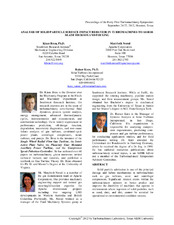| dc.description.abstract | Solid particle admission is one of the principal damage and failure mechanisms in turbomachines such as gas turbines, axial, and centrifugal compressors. Significant interest exists within the turbomachinery industry to better predict and improve the durability of machines that operate in environments where ingestion of solid particles, such as sand, dust, and dirt, cannot be avoided for operational or environmental condition reasons. This paper describes the development of a mixed Computational Fluid Dynamics (CFD)-empirical software tool that allows a probabilistic analysis of the kinematic and impact behavior of solid particulates in the near-field of turbomachinery blades and impellers surfaces. The method has been successfully employed to predict the surface wear characteristics and fouling rates in several groundbased gas turbines and centrifugal process compressor applications. The method and tool employ a commercially available CFD solver to calculate the machine's steady-state flow field. The model then uses the output to determine a set of non-dimensional coefficients in a set of empirical functions to predict the statistical probability of a given weight and size or distribution of solid particles, impacting on a specified rotating or stationary surface. Based on this model’s output information, improved inlet air filtering techniques, optimized engine maintenance practices, and component designs can be realized. To determine the empirical coefficient and to validate the method, Particle Image Velocimetry (PIV) testing was performed on an airfoil in a wind tunnel; then particle injection into a full scale centrifugal impeller was tested on Southwest Research Institute’s (SwRI) high-speed compressor test rig. Results from these tests allowed optimizing of the model to reflect rotating machinery particle impact behavior more accurately. | en |


